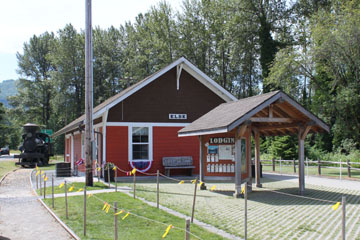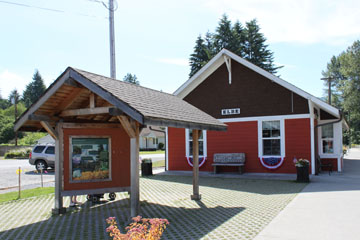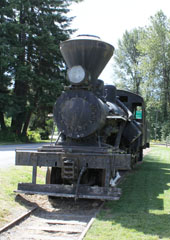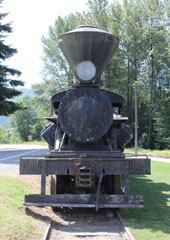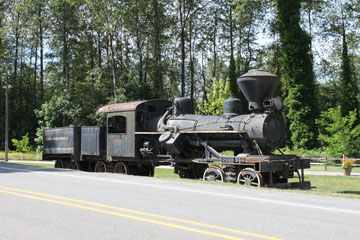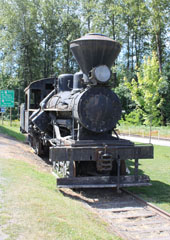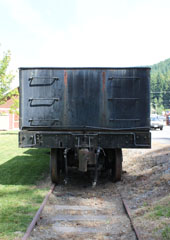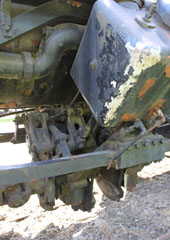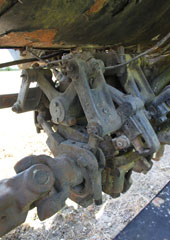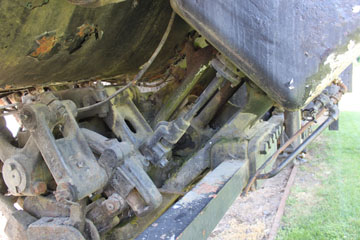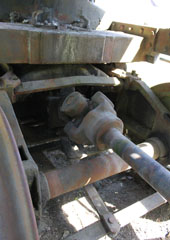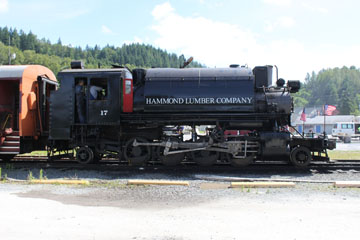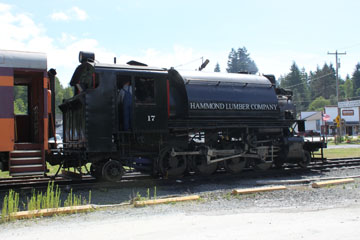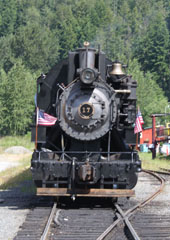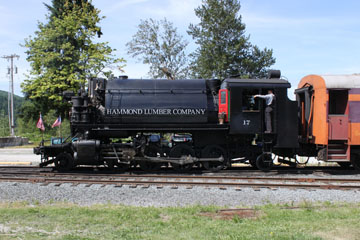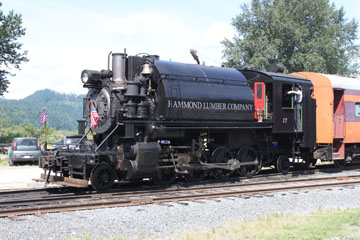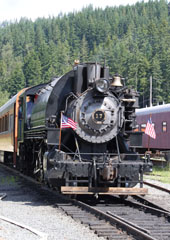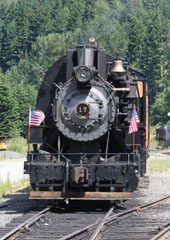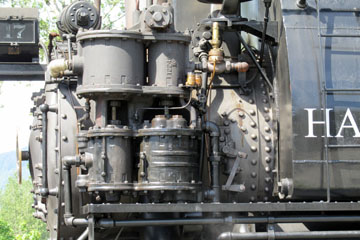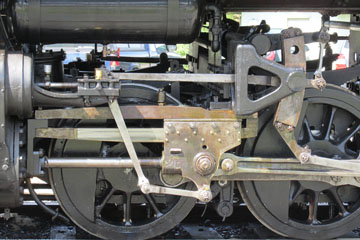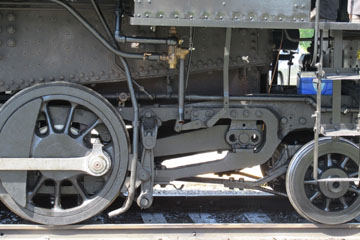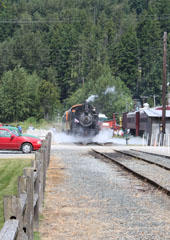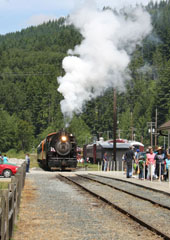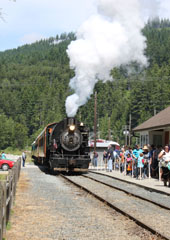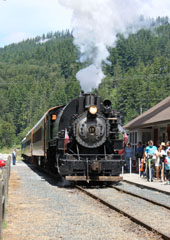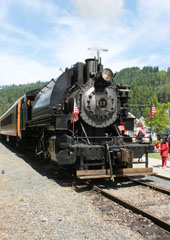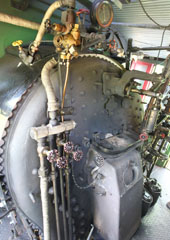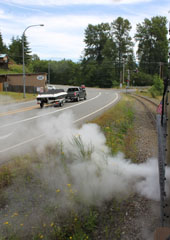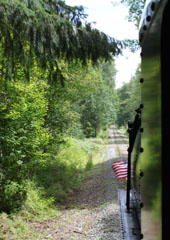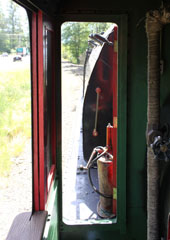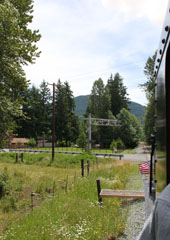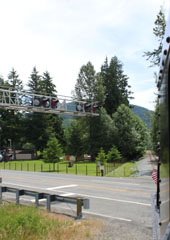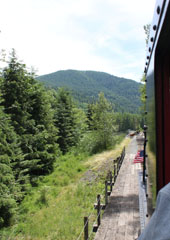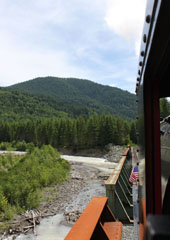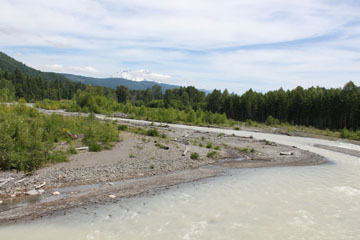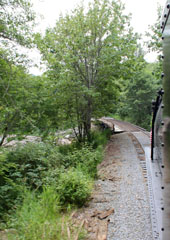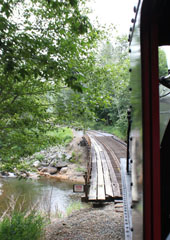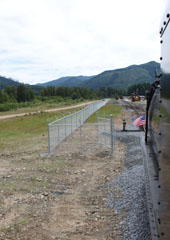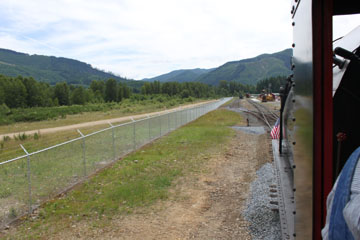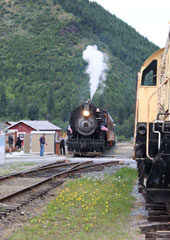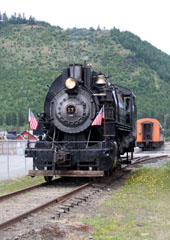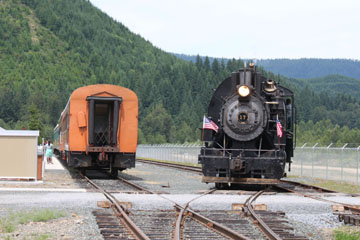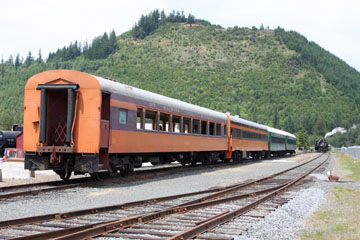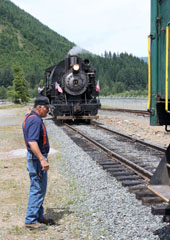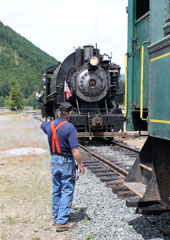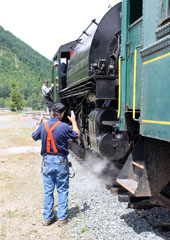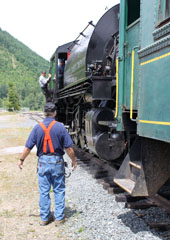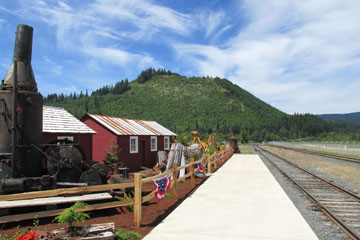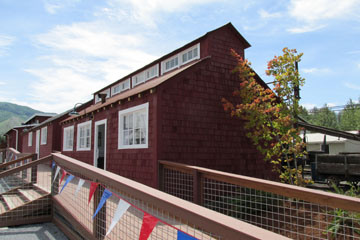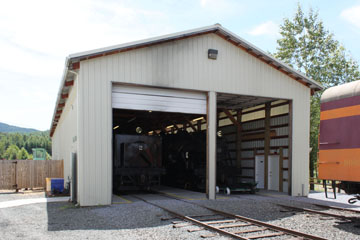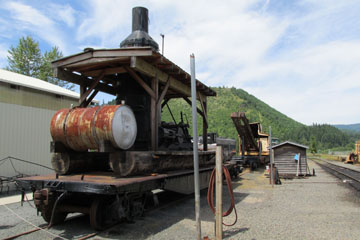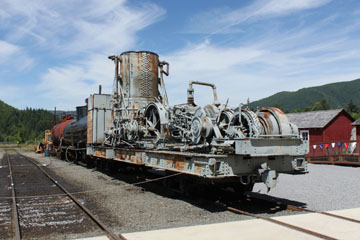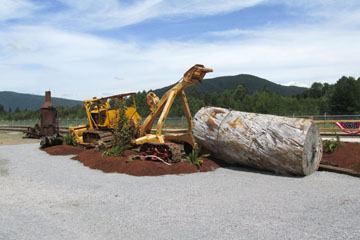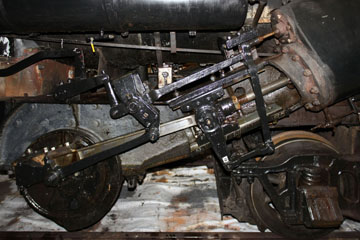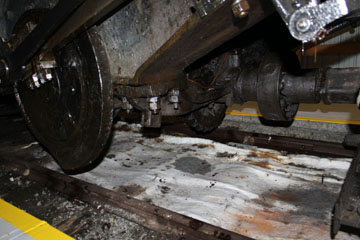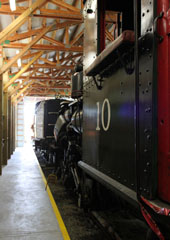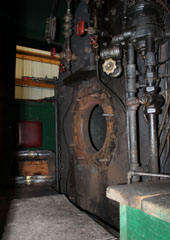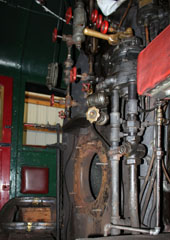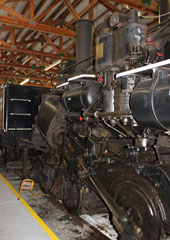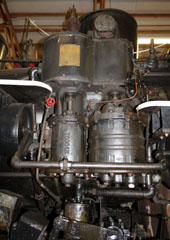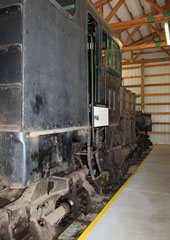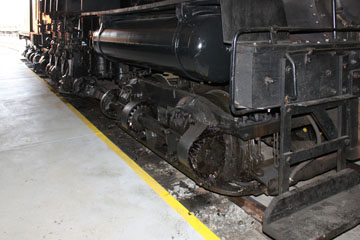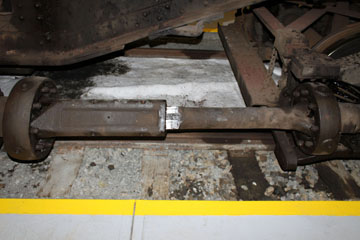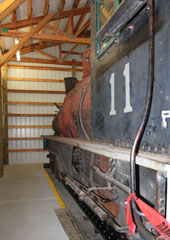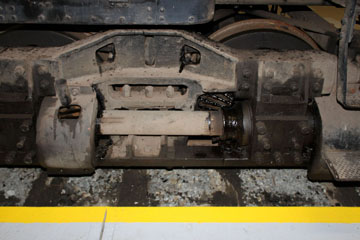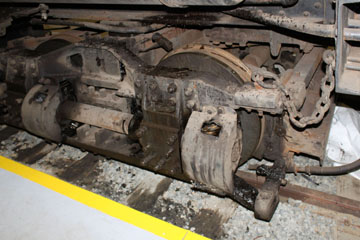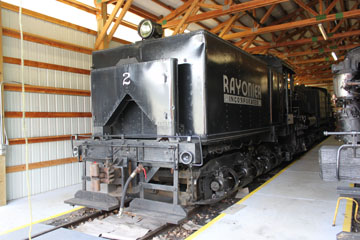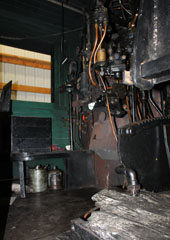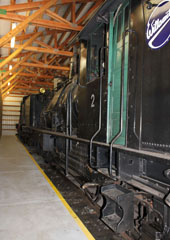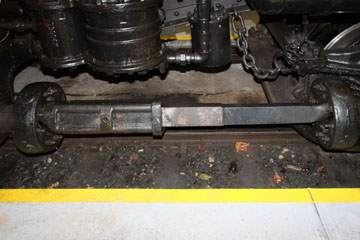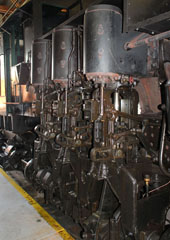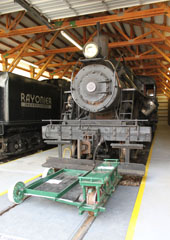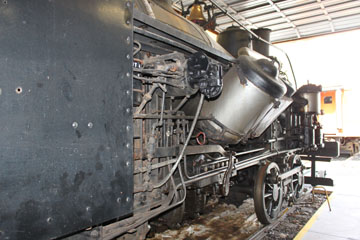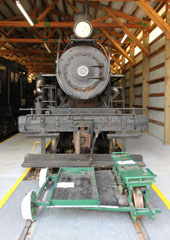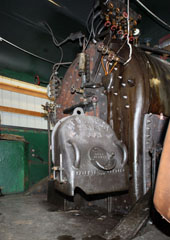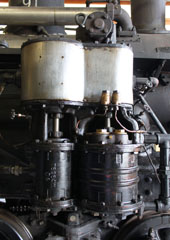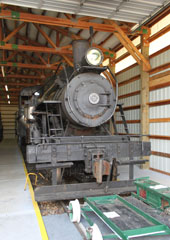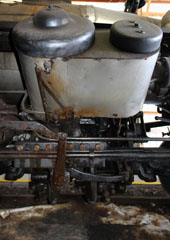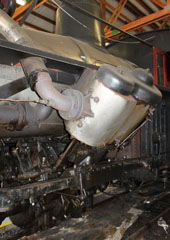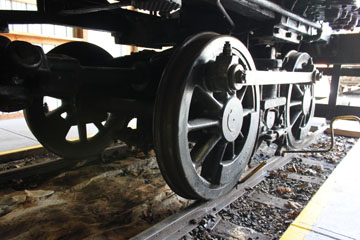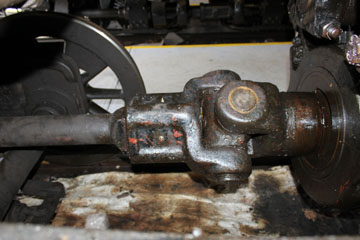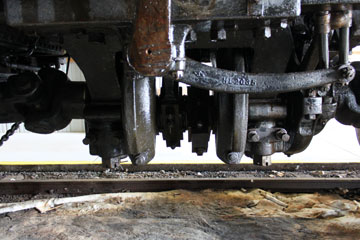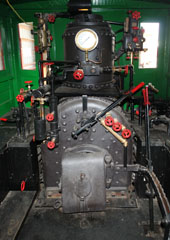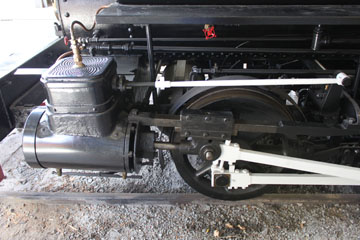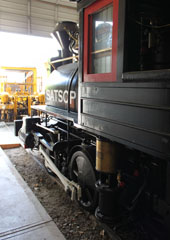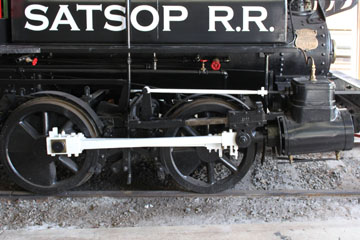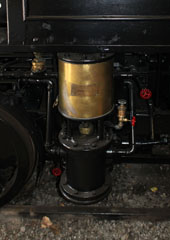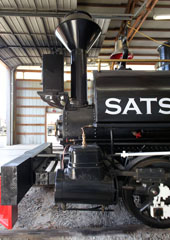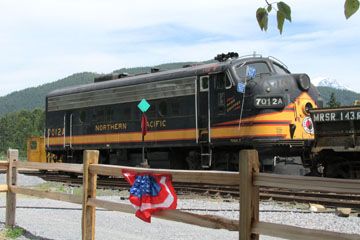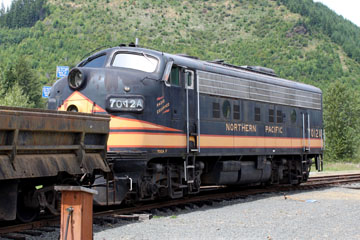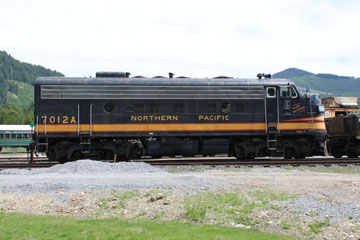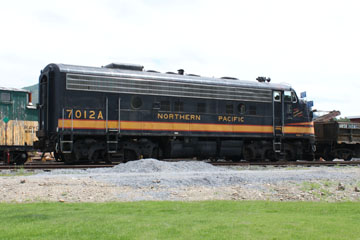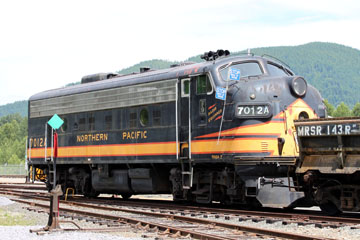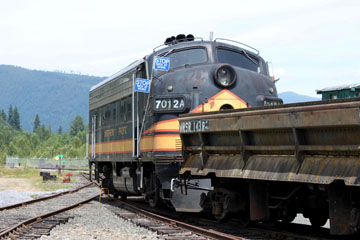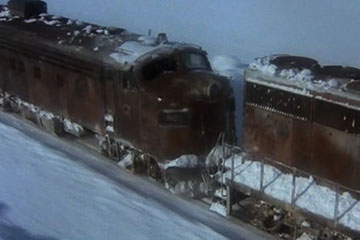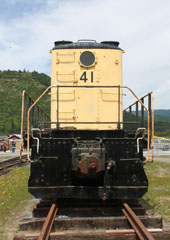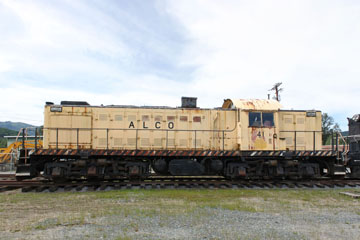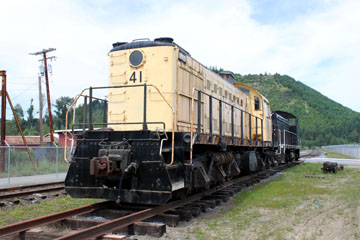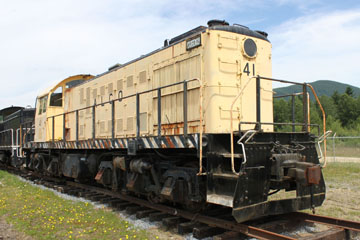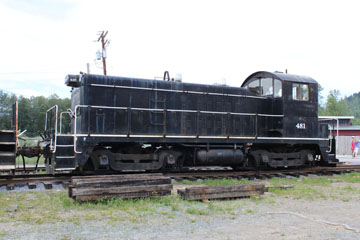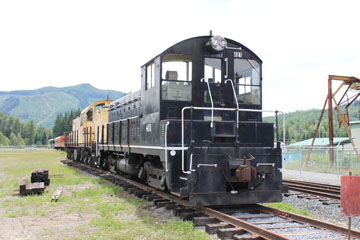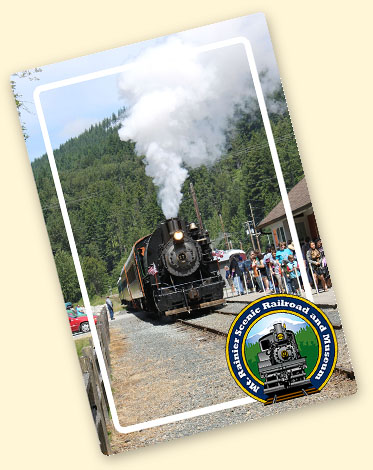

The Mount Rainier Scenic Railroad is the longest continuously operating steam railroad in the Pacific Northwest, running on track that was started in 1887 from Tacoma, WA, by the Tacoma Eastern Railroad.
The Tacoma Eastern was acquired in 1900 by a group of investors with financial interests in the Nisqually Coal Fields east of Elbe, resulting in extension of the line to the area where the MRSR now operates. The line was also extended south of Mount Rainier, eventually reaching Morton. From 1901, the railroad was controlled by the Milwaukee Road, although it remained a subsidiary owned through stock interest until 1918, after which it was absorbed into the parent company, although it continued as an independent entity until MILW's bankruptcy in 1980.

The Tacoma Eastern portion of the railroad was bought by
the Weyerhaeuser
Corporation, which used the line to move logs from Thurston and Lewis counties to a facility at the Port of Tacoma for export.
Tacoma lumberman Tom Murray Jr., struck a deal to open a seven-mile segment of the line from Elbe to Mineral.
Murray wanted a tourist line for historic equipment he had stored in Tacoma, and the MRSR was born.
Weyerhaeuser maintained control of the track until 1998 when it transferred control of all of its rail interests to the City of Tacoma, although this did not affect the MRSR and its tourist operations, which continue to operate today.
Elbe was once a thriving lumber town known as Brown's Junction, established after the Tacoma Eastern arrived in April 1904.
When a post office arrived, however, a different name was required, and a meeting of settlers decided to honour the pioneer settler Henry C. Lutkens who had come from the Elbe valley in Germany.
The station stands on the site of the original Tacoma Eastern depot. It houses the MRSR ticket office, a gift shop and the Mount Rainier Regional Visitor Center.

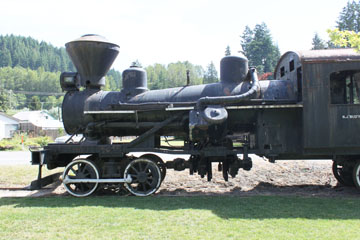
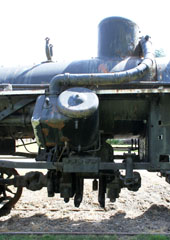
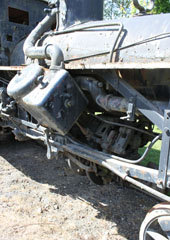
The "P. J. Lynch" worked for a number of loggers in West Virginia until sold by a dealer in 1922 to the Standard Lumber Co., of Standard, CA, where it was numbered #10.
After Standard Lumber became Pickering Lumber in 1926, #10 worked for nearly another forty years before retiring in 1963. The engine was then shipped with two other Pickering locomotives to a scrap yard in Stockton, CA, where it sat until 1966. At that time, Gus Peterson of Klamath, CA, was building a tourist railroad on part of his timber holdings in the California Redwoods. He moved #10 to Klamath and, by late 1967, the engine was steaming on the Klamath & Hoppow Valley Railroad.
An oil burner, #10 weighs 156,000 lbs. With 40” drivers and 18” x 15” cylinders, it operated at a boiler pressure of 180 psi delivering 30,000 lbs tractive effort.
Above and left, the characteristically slanted cylinder, gears and central drive rod.
In 1982, #10 was bought by the MRSR. It is now on static display outside the Elbe depot.


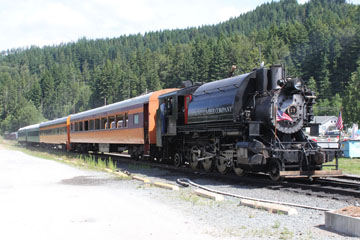
When we visited, Hammond Lumber Company #17 was lined up to haul the morning excursion from Elbe to Mineral.
This Mikado type saddle tank (2-8-2T) locomotive was built at Alco’s Schenectady, NY, works in 1929 as #11 for the Crossett Western Company in Wauna, OR. Saddle tank rod locomotives built by Alco are occasionally referred to as “Minaret” types, apparently named after the Minarets & Western Railway, a shortline operator in Fresno County, CA. A subsidiary of the company, the
Sugar Pine Lumber Company, rostered one
2-10-2T and four 2-8-2T rod locomotives also
built by Alco, but the type was also operated by other railroads.
The year #11 was delivered, much of the Crossett timber lands suffered a series of major fires known as the Tillamook Burn, and #11 worked through the 1930s and early 1940s hauling out timber salvaged from the burn. In 1942 it was sold to the Hammond Lumber Company in Samoa, CA, and renumbered #17.
Three years later, fire destroyed a series of trestles while the locomotive was at a logging camp known as “The Gap”. It was decided the cost of rebuilding the trestles was too great, and #17 sat at the camp unused for twenty years.
During that time, in 1956, Hammond Lumber was acquired by the Georgia-Pacific Corporation.
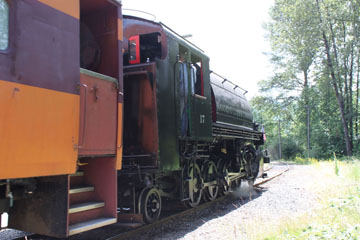
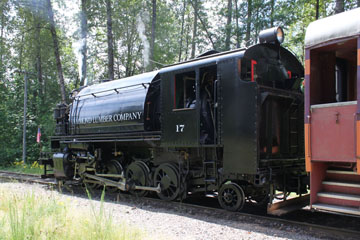
In 1965, a local mill owner named Gus Peterson bought #17 from Georgia-Pacific. He built a road into the old campsite, dismantled the engine, trucked it out piece by piece and then started work restoring it to operation.
On 27th September 1966, #17 made its debut on Peterson’s Klamath & Hoppow Valley Railroad.
The K&HVR was a short lived four mile lumber line in northern California which, from 1969, also operated as a tourist line. Klamath, CA, was off the beaten track and quite a distance from major population centres and, during the early 1970s, the gas crisis reduced tourist interest and led to the railroad’s closure. As a result, #17 was mothballed again.
Above, #17's backhead. There is no lagging on the backhead and its surface reaches a temperature of 360º F during operation.
An oil burner with
18” x 24” cylinders, #17 operates at a boiler pressure of 190 psi delivering 28,500 lbs tractive effort.
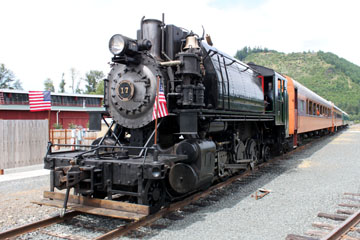
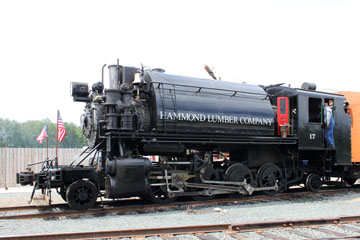
Above, #17 standing in the yard at Mineral. Passengers have a roughly forty minute stopover to explore the world’s most comprehensive collection of steam logging locomotives and learn about the MRSR restoration and repair work.
In 1980, #17 was sold with Pickering Lumber #10 and #11 to Tom Murray Jr., who had #17 disassembled and shipped by truck to Tacoma, WA, and then sent to the shops of the MRSR in Mineral, WA. During the 1980s, the engine sat outside the shops while restoration progressed on other locomotives. Work finally started on #17 in 1994 and then, in January the following year, it was fired up and joined the other locomotives operating on the MRSR.

With the closure of Camp 6 in 2011, the Western Forest Industries Museum and the MRSR initiated a project to bring together artefacts from Camp 6 with the Railroad’s facility in Mineral to create a “Railroad Camp”.
When we visited, the first phase of the project had brought six historic logging camp buildings dating back to the early 1920s to the site. Exhibits tell the stories of the men and women who lived and worked in logging camps, and explains the technologies used to move the lumber from the woods to the mills.
As its name suggests, the town of Mineral started as a mining concern. However, the mines failed and it then became the site of a logging camp and sawmill. Today, its main industry is tourism, primarily through recreational fishing but, about a mile to the southeast, the Mt. Rainier Scenic Railroad now operates its museum.
A large collection of artefacts and railroad camp buildings were displayed for several decades at
the Camp 6 Logging Museum at Point Defiance Park in Tacoma, WA. Over the period, the MRSR had also assembled examples from every major manufacturer of steam logging locomotives, as
well as other pieces of historic logging
equipment.

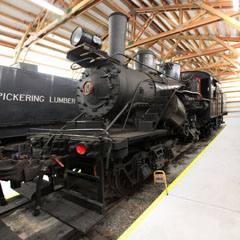
Hillcrest Lumber bought this three truck locomotive in 1928 from the Climax Locomotive Works in Corry, PA. The second to last Climax built, it was delivered as #3 in May that year to the company’s operations at Mesachie Lake on Vancouver Island, BC. At some point, it was renumbered #10.
Weighing 140,000 lbs with
14½” x 16” cylinders and 36” drivers, #10 operates at a boiler pressure of 180 psi delivering 30,800 lbs tractive effort.
In 1968, when the Mesachie
Lake mill shut down, #10 was the last Climax in regular operation
in the world. That year, it was
sold to a collector who planned
to use it on the Victoria Pacific tourist railroad in Victoria, BC,
but the operation never got started. In 1979, the locomotive was bought by the MRSR, restored and became the first steam engine to operate for the railroad.
A Climax is a geared locomotive in which two steam cylinders set at an angle on each side of the boiler drive a transmission located under the centre of the boiler to transmit power to driveshafts running to the front, middle and rear trucks. Production began in 1888, and the basic design was patented by Rush S. Battles in 1891. Charles D. Scott, a logger and inventor who lived in Pennsylvania, patented improved versions of Battles' trucks in 1892 and 1893.
Above, the crank shaft, valve gear and cylinder on the engineer's side.
Above, the geared central drive shaft.
The Climax was the second most popular logging locomotive after the Shay. Loggers would say it would "follow 2 lines scratched in the dirt" as a testament to its ability to tackle rough, uneven logging track.

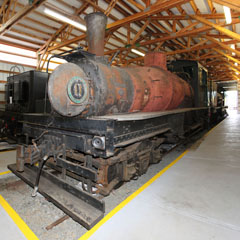
This locomotive was built in
1929 by the Lima Locomotive Works in Lima, OH, for the
Forest Lumber Company of Pine Ridge, OR, as #5. A three truck Shay, it was ordered with an extended oil bunker to provide greater range between fuel stops. The bunker has a capacity of 1,500 gallons of oil and 4,000 gallons of water.
The engine weighs 161,600 lbs and has three 13” x 15”
vertically mounted cylinders. Operating at a boiler pressure of 200 psi, it delivers 38,200 lbs tractive effort.
In late 1940, when Forest
Lumber shut down, #5 was sold
to the Pickering Lumber Corporation in Standard, CA,
and renumbered #11. In early 1941, soon after being delivered, the engine was badly burned in a roundhouse fire. The company decided #11 was not worth repairing and planned to scrap the locomotive.
In 1981, #11 was bought by the
MRSR . It returned to steam in the early 1990s.
#11 is one of twenty-four Pacific Coast Shays designed by Lima to compete with output from the Willamette Iron & Steel Company in Portland, OR. Willamette included as standard many features that Lima charged extra for but, on the Pacific Coast Shay, Lima offered the same features as Willamette.
The locomotive then hauled log trains for Pickering until late 1964 when the company converted to diesel motive power.
Two years later, #11 was sold to
Tom Irion and trucked to the
Western Railway Museum near Rio Vista, CA, where it occasionally operated. In 1969, it was bought by Gus Peterson who planned to use #11 on the Klamath & Hoppow Valley Railroad.
Shay locomotives are geared on the right side of the engine. Power is transmitted from the
cylinder rods by a drive shaft running the length
of the three trucks. The shaft has a universal
joint and square sliding slip joints to
accommodate the trucks' swivelling motion. Drive is transferred to the wheels by bevel gears. Above, a slip rod on the horizontal drive shaft. Left and below, views of the truck showing the drive shaft and bevel gears.
The cylinder position imparts a "lop sided" look to Shays when viewed from the front end.
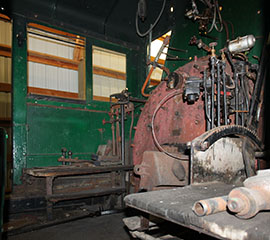
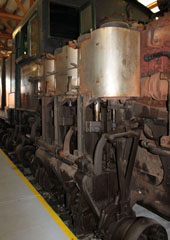
When WW II started and the lumber market picked up, however, management changed their minds and rebuilt #11.
Of the twenty-seven Pacific Coast Shays built by Lima only five survive, and #11 is one of three
that still operate. It is also the heaviest Pacific Coast Shay built. You can see another Pacific Coast Shay on the Cass Scenic Railroad page of this website.
Two thousand, seven hundred and sixty-eight Shay locomotives were built by Lima from 1878 to 1945 in four classes, ranging in size from 6 to 160 tons. You can see other Shays on the Travel Town, Northwestern Railroad Museum and B&O Museum Roundhouse pages of this website.
You can also see other Pickering Lumber locomotives on the Pickering Lumber #3 and Railtown 1897 pages.

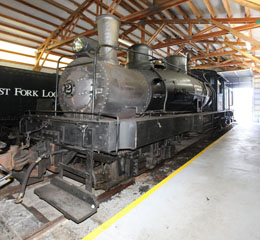
This is the last engine built by the Willamette Iron & Steel Works in Portland, OR. It was destined for the J. Neils Lumber Company in Klickitat, WA, arrived in December 1929 and was numbered #6.
An oil burner weighing 182,000 lbs with three 12” x 15” cylinders and 36” drivers, it operates at a boiler pressure of 200 psi, delivering
34,687 lbs tractive effort.
The Willamette Works had supplied donkey engines and other steam operated equipment to loggers in the Pacific Northwest from the turn of the 20th Century and had also become known for its ability to repair steam locomotives used by loggers, many of which were Shays built by the Lima Locomotive Works in Lima, OH. In 1921, several of Lima’s patents for the Shay expired and, at the same time, Willamette hired one of Lima’s principal design engineers for the Shay. These two events led Willamette to announce they were entering the geared logging locomotive field.
In 1949, #6 was sold to Rayonier to work at Sekiu, WA. Renumbered #2, it operated there until 1962, when diesels replaced steam. That year Jim Gertz bought #2 on condition that he remove it from Rayonier’s property, although it took more than a year to move the locomotive to his home in Port Angeles, WA, where he built a shed to keep the engine protected from the weather.
In 2002, after forty years in storage, Gertz donated #2 to the MRSR. Restoration started in 2006 and the locomotive made its first public appearance in steam on 8th August 2009.
From 1922 to 1929, the Willamette Works built thirty-three geared locomotives, incorporating refinements such as all-weather cabs, girder frames, super-heaters and piston valves, but the competition did not go unchallenged. Lima developed the Pacific Coast Shay and Heisler the West Coast Special Heisler. Pacific Coast Shay Pickering Lumber #11 is shown earlier on this page, and you can see West Coast Special Heisler West Fork Logging #91 next.
Only the Climax Works did not produce a model to compete with the Willamette as its sales had already dropped substantially by then and, in 1928, the company ceased construction of locomotives entirely.
Of the thirty-three locomotives built by
the Willamette Works, #2 is one of six survivors, and the only operational Willamette in the world.
You can see other surviving Willamettes on the Western Lumber #7 page of this website, the Anderson & Middleton Lumber #2 page and the Rayonier #4 page.

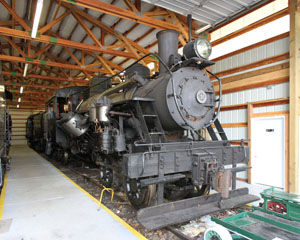
#91 is a West Coast Special built by the Heisler Locomotive Works in Erie, PA. Invented by Charles Heisler in 1892, the design combined the flexibility of a geared locomotive with increased speed, a key advantage over its major competitors, the Shay and Climax.
When the Willamette locomotive was introduced in 1922, Heisler was the first victim of this new competitor. The Coos Bay Lumber Company of Coos Bay, OR, had ordered a new 3-truck Heisler in early 1922 but cancelled the order when Willamette sold them their first geared logging locomotive.
At first, neither Lima, builder of the Shay, nor Heisler took Willamette's competition seriously but, as the company's business grew, both manufacturers decided they had to do something. Lima developed its Pacific Coast Shay and Heisler its West Coast Special incorporating refinements that were standard in the Willamette, including all-weather cabs, girder frames, super-heaters and piston valves. The West Coast Special was the largest and most advanced Heisler ever built.
The Whitney Engineering Company in Tacoma, WA, the West Coast dealer for Heislers, ordered this three truck locomotive in 1929 as stock.
Two years later, Whitney sold the engine to the Kinzua Pine Mills in Kinzua, OR, where it was numbered #102. When Kinzua began dieselisation in the 1950s, while its Shays were scrapped, #102 was retained as back up to the diesels. By the early 1960s, however, the Heisler had outlived its purpose and was sold and shipped to the Vernonia South Park & Sunset tourist railroad in Vernonia, OR.
Weighing 198,000 lbs, #91 has 18¼” x 16” cylinders and 40” drivers. Operating at a boiler pressure of 200 psi, it delivers 43,000 lbs tractive effort.
Instead of vertical cylinders and pistons with a
side drive shaft geared to the trucks as on the Shay, the Heisler's cylinders were set at 45° angles on each side of the boiler. The piston rods form a "V" connection to a central crankshaft that attaches to gears in an enclosed gear box on the furthest axle on each truck. Power was transferred to the other wheel on each truck by external connecting rods.
The enclosed gear box made the Heisler better suited to mining and quarry work than other geared locomotives.
Top, a view of the right side of #91's front truck. Lower photo, the knuckle joint connecting the central portion of the crankshaft and rear truck allows the truck to pivot when taking curves.
#102 never steamed at Vernonia. In 1965, it was sold to Clyde Schurman, a machinist who
displayed the engine at his machine shop in Woodland, WA. In 1978, it was sold to Tom Murray Jr., who donated the locomotive to the MRSR. Renumbered #91 in honour of an earlier three truck Heisler that worked out of Mineral, WA, for the West Fork Logging Company, an operation founded by the father of Tom Murray, it was the second engine restored to operation at Mineral, WA.

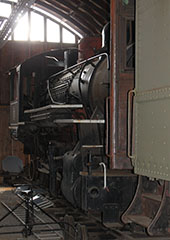
Tucked out of view when we visited, I got only one shot of #5.
At 142,000 lbs,
112,000 lbs on its 44” drivers, #5 is one of the largest locomotives built by the H. K. Porter Company in Pittsburgh, PA. A Mikado type
(2-8-2) oil burner operating at a boiler pressure of 180 psi, it has 18" x 24" cylinders and delivers 26,435 lbs tractive effort.
The locomotive was ordered by the Flora Logging Co., as #11 in 1924 and later sold to the Carlton & Coast Railroad. In 1940 the C&C was abandoned and #11 was sold to
the Port of Grays Harbor to switch at the docks in Hoquiam, WA, and renumbered #5.


When we visited, this Mikado type (2-8-2) locomotive was in the restoration shop.
Logging railroads relied on two types of motive power. Geared locomotives worked well on rough and twisting track out in milling areas but, as these moved further away from the mills, their relatively slow speed could delay production.
The second type of motive power comprised small drivered rod engines, of which #45 is a good example. The small drivers were suitable for the steep grades found on logging tracks and the front and rear trucks helped maintain good tracking.
The rod type was also faster, which enabled it to collect loads deposited by geared engines working at the cutting site and move these on better built track from camp to mill.
Polson Logging in Hoquiam, WA, took delivery of #45 in January 1906.
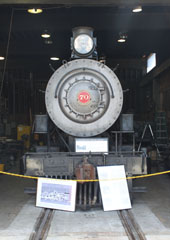
A wood burner built by Burnham, Williams & Co., an early
incarnation of the Baldwin Locomotive Works, #45 has a driver wheelbase of 9’ 2” and engine wheelbase of 23’ 9”.
It weighs 99,000 lbs, 66,000 lbs on its 44” drivers.
Some time in the
1920s, #45 was converted to burn oil. It has a 14.13 sq ft grate, 86 sq ft firebox and
total heating surface of 1,074 sq ft. Operating
at a boiler pressure of 180 psi, it delivers 16,700 lbs tractive effort.
In 1945 Polson
Logging was sold to Rayonier and #45 continued to work until retired in 1960 and donated to the City of Hoquiam, WA. Put on open air display, by 1998 its condition had deteriorated badly. That year, the City of Hoquiam donated #45 to the MRSR and the engine was shipped to Mineral, WA.
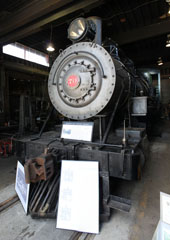
It has 15” x 24” cylinders and is equipped with Stephenson valve gear.



Above, built in 1885 by H. K. Porter in Pittsburgh, PA, for the Satsop Rail Road, this 0-4-2T (Tank) locomotive was placed on open air display at the Supermall in Auburn, WA, in 1995. Right, it was subsequently donated to the MRSR in 2013 and moved to the MRSR shops in Mineral.
Originally named “Currie” when it was built, the locomotive’s name was soon changed to “C. F. White”. It was the first of the Satsop’s motive power, followed in 1887 by another Porter, the 2-6-0 “Agnes” and then a Baldwin 4-6-0 the “William Shorter”. A coal burner, #1 weighs 30,000 lbs, has 33” drivers and 9½” x 14” cylinders. Operating at a boiler pressure of 140 psi, it delivered 4,550 lbs tractive effort.
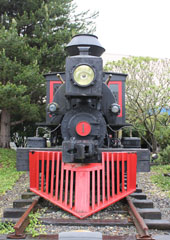
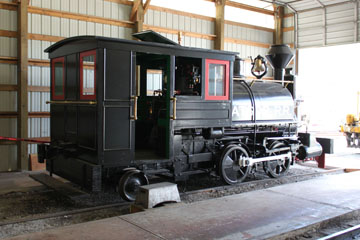
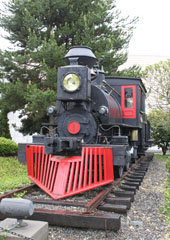
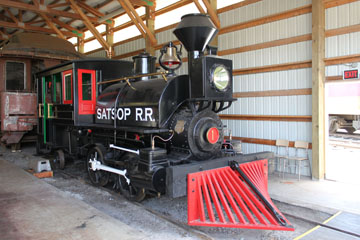
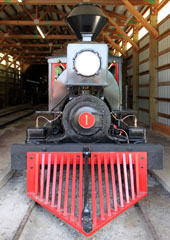
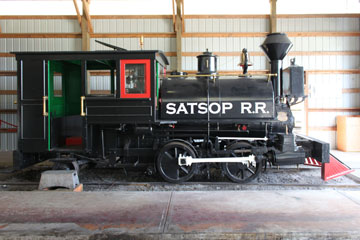
The Satsop Rail Road was a shortline on Washington State's Olympia Peninsula that took its name from the timber rich Satsop River.
The Satsop had initial trackage of five miles of standard gauge track out of Shelton.
About the time #1 was purchased, the line had grown to twenty-four miles in length and it was subsequently taken over by the Washington Southern Railway Co., in 1891,
The Washington Southern was then amalgamated to form the Peninsular Railway Co., in 1895 as a subsidiary of the Simpson Logging Co.

This F9 diesel electric locomotive was built by EMD in 1956 for the Northern Pacific Railroad as #7012A. It was one of thirty A units bought by the NP (#7000A-#7014A & #7000D-#7014D). The railroad also purchased thirty B units (#7000B-#7014B & #7000C-#7014C) as well as eight F9 passenger units (#6700A, #6700C, #6701A, #6701C, #6702A–#6704A & #6500C) and two passenger B units (#6700B–#6701B).
#7012A was renumbered Burlington Northern
#838 in 1970 and was donated to the MRSR in
1982.
#7012 is equipped with a Winton 567C 16 cylinder prime mover driving a 1,750 hp GM D12D generator to power four GM D37 traction motors, one on each axle, delivering starting tractive effort of 56,500 lbs at 25% and 40,000 lbs continuous tractive effort at 9.3 mph.
In 1985, #7012A had a supporting role in the
movie Runaway Train starring Jon Voight. Rail
yard sequences were filmed on the Butte, Anaconda & Pacific Railway in Anaconda, MT,
using units from the BA&P. The film is set in Alaska, and #7012A, renumbered #500, was fitted with plywood boxes to simulate the distinctive 'winterization hatches' carried on Alaskan Railroad diesels.

Built in 1941, this Alco RSD-1 diesel electric
started life as Chicago, Rock Island & Pacific Railroad #747 in early 1942. It was one of four
Rock Island RS-1s (#746-#749) commandeered by the War Department in late 1942 and rebuilt as RSD-1 units. #747 was renumbered USA #8004 and spent the WWII years operating on Iranian State rail lines.
In 1951, #8004 was bought by the Alaskan
Railroad and renumbered #1041. Five years later,
it went back to the US Army and returned to #8004. It went to the Department of Transportation and was moved to the Pueblo Transportation Test Center in Pueblo, CO, where it was renumbered #8025.
A number of RSD-1s have survived.
You can see ARR
#1034 on the Pennsylvania Railroad Museum Yard page of this website, OERM #1975 on the Orange Empire Railway Museum page and USA #8651 on the National Railroad Museum page.
The unit may also have spent time at the Federal Railroad Administration as #011 before joining the roster at the MRSR.

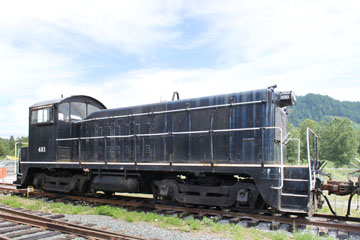
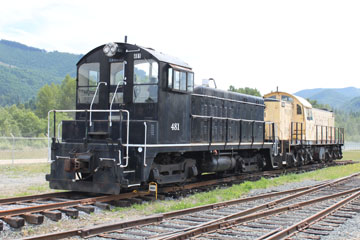
This is an NW2 diesel electric locomotive built by EMD for the Great Northern Railway in September 1942 as #5336. It was later renumbered #1713 and then became #481 in 1970 with formation of the Burlington Northern Railroad. After retirement in 1982 it was bought by Pacific Transportation Services and renumbered #103. Shortly after, it became Cargill #481 and then, in 1990, it was bought by Louis Dreyfuss who donated it to the MRSR in 2001.
One thousand, one hundred and forty-five NW2s were built by EMD between 1939 and 1949, one thousand, one hundred and twenty-one for US railroads and twenty-four for railroads in
Canada.
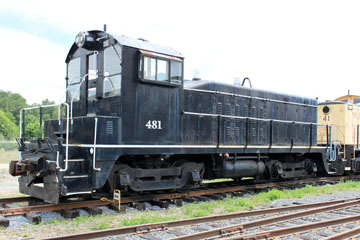
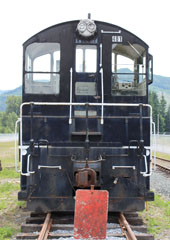
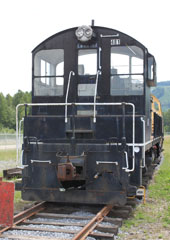
The NW2 is equipped with a 12 cylinder EMD 12-567 prime mover driving a GM-D15C generator to power four GM-D37 traction motors, one on each axle. It developed 62,500 lbs starting tractive effort at 30% and 31,000 lbs continuous tractive effort at 11 mph with a top speed of 65 mph. Distinguishing features of the NW2 are the half-height radiator grille at the front and the two stacks in the middle of the hood.
You can see more NW2s on the Pennsylvania Railroad Museum Yard page of this website, the Virginia Museum of Transportation page, the Tennessee Valley Railroad page, the Monticello Railway Museum page and the Strasburg, CO, page.


